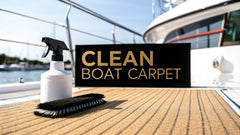Cleaning Marine Vinyl Like a Pro
Cleaning marine vinyl is about more than just a quick wipe-down. It’s a specific process that calls for gentle cleaners and soft brushes to get rid of tough stuff like salt and mildew without hurting the material itself. Do it right, and your vinyl stays supple and resists cracking for years to come.
Why Your Marine Vinyl Needs Specialized Care
Let's be honest, your boat's vinyl upholstery lives in one of the toughest environments out there. Unlike the couch in your living room, it’s in a constant battle with UV rays, saltwater spray, wild temperature swings, and non-stop moisture. This relentless attack is exactly why specialized care isn't just a good idea—it's essential if you want to protect your investment.
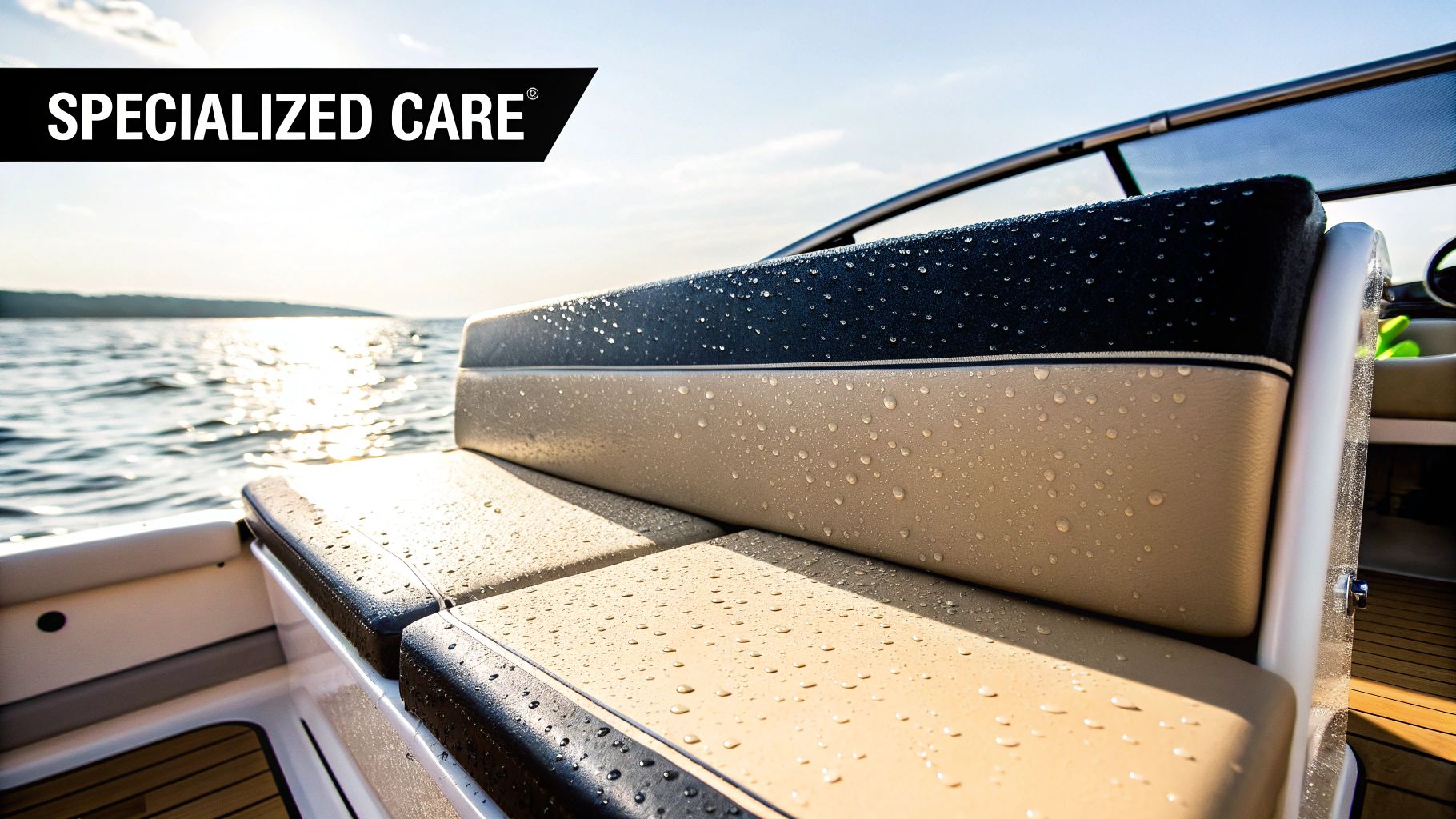
Without a proper routine for cleaning marine vinyl, these materials start to break down fast. Sunscreen, full of oils and chemicals, is a major culprit, causing ugly yellowing and eating away at the vinyl's protective topcoat. Saltwater is just as bad, leaving behind abrasive crystals that suck the moisture right out of the material, leading to premature cracks and brittleness.
The Hidden Enemies of Boat Upholstery
Beyond the obvious threats, mildew is always lurking. The tiny pores in marine vinyl are perfect traps for moisture, creating an ideal breeding ground for stubborn, damaging mold. A simple wipe often just cleans the surface, leaving the roots embedded deep in the material, ready to grow back.
Neglecting your vinyl doesn't just make your boat look bad; it hits you right in the wallet. Faded, cracked, and mildew-stained upholstery is a huge red flag for potential buyers and can seriously tank your boat's resale value.
This need for proper care is mirrored by a growing industry focused on creating tougher, better-looking materials. The global marine vinyl market was valued at a whopping USD 340.80 million in 2023 and is only expected to grow as boat owners demand more from their upholstery. As you can read on grandviewresearch.com, innovations in UV resistance and advanced textures are pushing the market forward, making it even more critical to care for these modern fabrics correctly.
Ultimately, a dedicated care regimen tackles the key challenges head-on:
- UV Damage: It stops the sun from breaking down the plasticizers that keep vinyl soft, which is what leads to fading and cracking.
- Stain Prevention: A good protectant creates a barrier against common spills, sunscreen, and everyday grime, which makes your next cleanup a whole lot easier.
- Mildew Inhibition: The right products keep moisture out, stopping mold and mildew in their tracks before they can cause permanent stains.
When you understand these unique pressures, it’s easy to see why your average household cleaner just won't cut it. They can strip away protective coatings, speed up the aging process, and do way more harm than good.
Building Your Marine Vinyl Cleaning Arsenal
If you want professional results when cleaning your boat’s vinyl, it starts with having the right tools on hand—and I don’t mean just any old soap and water. Grabbing common household products like dish soap might seem like a quick fix, but they often leave behind sticky residues that actually attract more dirt.
Worse yet, aggressive cleaners like bleach or ammonia are a death sentence for marine vinyl. They strip away the essential plasticizers that keep the material flexible, eventually leading to a brittle, cracked mess. This is why a dedicated, pH-balanced marine vinyl cleaner is a must; it's formulated to lift away grime without damaging the material's protective topcoat.
Choosing the Right Tools for the Job
The tools you use are just as important as the cleaner itself. Step away from the abrasive pads or stiff-bristled brushes. While they might seem tough on dirt, they’ll create tiny micro-scratches across the vinyl, dulling the finish and creating a perfect new home for future grime to get trapped in.
Your absolute best friend for this job is a soft-bristled brush. Its bristles are gentle enough to be safe but firm enough to work the cleaner deep into the vinyl’s texture, lifting out that embedded dirt and stubborn mildew from within the grain.
Once you're done scrubbing, high-quality microfiber towels are non-negotiable for the finishing touch. Unlike old shop rags or paper towels that just smear things around, microfiber is super absorbent. It traps any leftover dirt and cleaner residue, leaving behind a dry, streak-free surface that helps prevent water spots and stops new mildew from getting a foothold.
This simple infographic breaks down the core components of an effective cleaning kit perfectly.
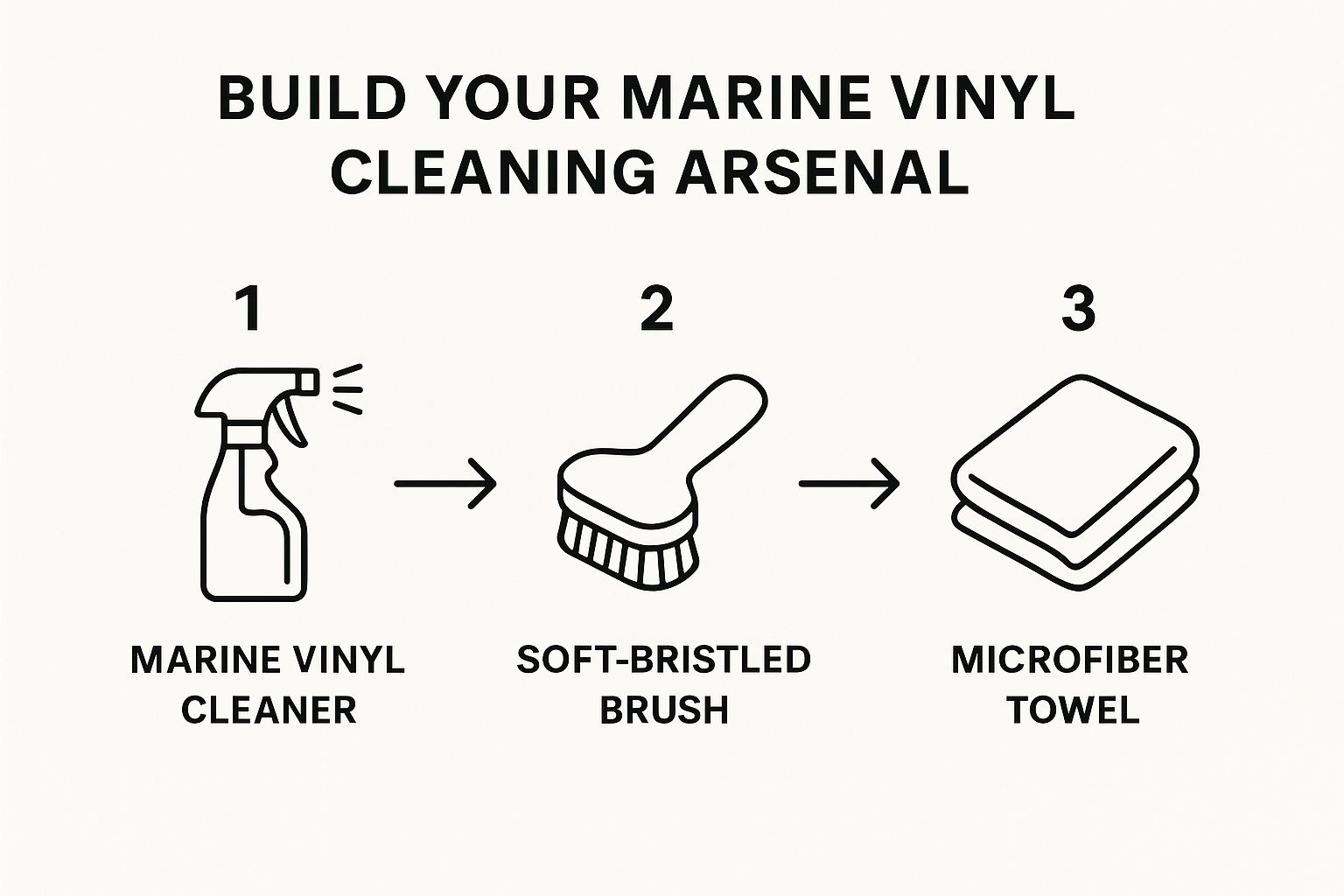
As you can see, it’s a straightforward process: use the right cleaner, agitate with a safe tool, and finish with a proper drying method. It's a simple, effective arsenal that ensures you’re ready to tackle any mess the right way.
If you’re looking for a deeper dive into product options, this guide to the best boat vinyl cleaner is a great resource to find the perfect match for your boat.
Essential vs. Damaging Cleaning Agents for Marine Vinyl
It’s easy to grab something from under the kitchen sink, but the wrong choice can cause irreversible harm to your boat's upholstery. This table gives you a quick-reference guide to what works and what to avoid at all costs.
| Safe for Marine Vinyl | Potential Damage | Harmful Products to Avoid |
|---|---|---|
| pH-Balanced Marine Vinyl Cleaners | Formulated to clean without stripping protective layers. | Gentle yet effective on dirt, mildew, and grime. |
| Mild Soap & Water (in a pinch) | Can leave a residue that attracts dirt if not rinsed well. | Not ideal for deep cleaning or stubborn stains. |
| 303 Multi-Surface Cleaner | Specifically designed for UV protection and cleaning. | One of the most trusted names for marine surfaces. |
| Harmful Products to Avoid | Potential Damage | Why It's Bad |
|---|---|---|
| Bleach | Dries out vinyl, causing it to become brittle and crack. | Strips color and weakens the material's integrity. |
| Ammonia-Based Cleaners (like Windex) | Breaks down the vinyl's topcoat, leading to fading. | Removes plasticizers needed for flexibility. |
| Abrasive Powders (like Comet) | Scratches the surface, dulling the finish permanently. | Creates microscopic grooves that trap dirt. |
| Magic Erasers | Acts like fine-grit sandpaper, abrading the vinyl's finish. | Causes a dull, hazy appearance over time. |
Using the right products isn't just about getting things clean today; it's about protecting your investment for years to come.
The Pro's Method for a Flawless Clean
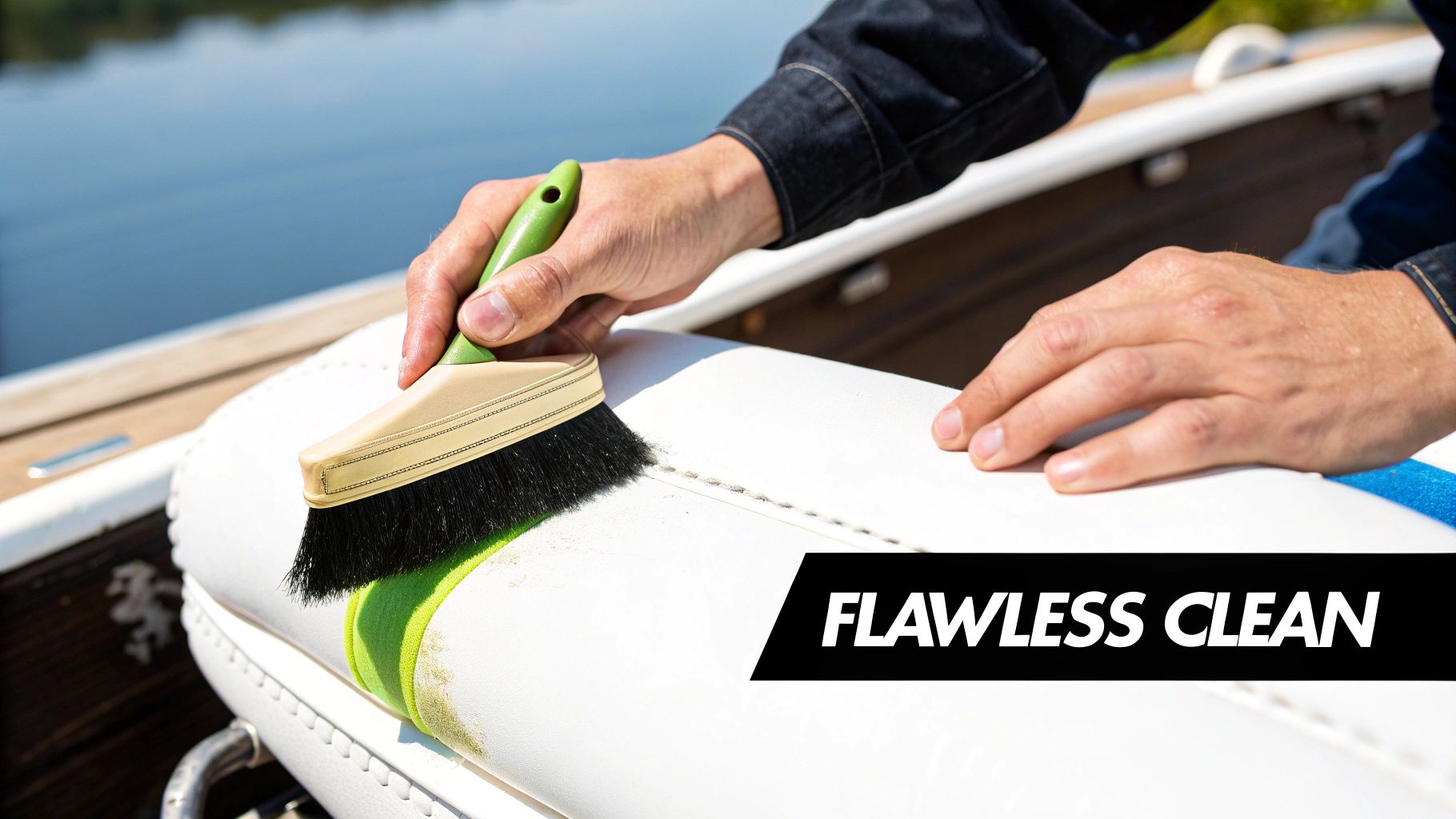
With your gear in hand, you're ready to get to work. A true, deep clean isn't about scrubbing harder—it's about working smarter. This is a methodical process that removes the grime without harming the material. If you rush through it, you'll leave behind invisible residue that just invites mildew to come right back.
The very first thing you should always do is give the vinyl a thorough freshwater rinse. It’s a simple step, but it's crucial. This gets rid of all the loose stuff on the surface: salt, dust, bird droppings, you name it. Trying to scrub a gritty surface is like taking sandpaper to your vinyl, creating tiny scratches that dull the finish.
Once the loose debris is gone, you can start the real cleaning. I always recommend working in small, manageable sections, maybe two-by-two feet at a time. This keeps the cleaner from drying out before you can properly work it in and rinse it off.
Mastering the Application and Agitation
Grab your marine vinyl cleaner and spray it generously on your first section. You want complete, even coverage. Let it sit for a minute or two. This is key—it gives the cleaner time to penetrate and start breaking down the grime's bond with the vinyl. Just don't let it dry.
Now, take your soft-bristled brush and gently start working the surface. Use small, overlapping circular motions instead of just scrubbing back and forth. This technique is much more effective because it lets the bristles get down into the vinyl's texture, lifting out the embedded dirt that a simple wipe always leaves behind. You should see a light foam start to form, which tells you the cleaner is doing its job and pulling up the gunk.
Pro Tip: For really stubborn spots, like around the seams or on the captain’s chair where it gets the most use, you might need to go over it a second time. It’s always better to do two gentle cleanings than one aggressive scrub that could damage the vinyl.
The Critical Final Rinse and Dry
This is where a lot of people go wrong. As soon as you finish agitating a section, you need to rinse it immediately and thoroughly with fresh water. The goal is to wash away 100% of the cleaner and all the dirt it lifted. If you leave any soapy residue, it becomes a sticky magnet for new dirt and can even break down the vinyl’s protective topcoat over time.
The final touch is to dry the area completely with a clean microfiber towel. Letting vinyl air-dry can leave behind ugly water spots. More importantly, it leaves moisture behind, which is exactly what mildew needs to thrive. A good wipe-down is your final line of defense, leaving the surface perfectly clean, dry, and prepped for a protective treatment. This detailed approach to cleaning marine vinyl is what makes the difference between an amateur job and a professional finish that actually lasts.
How to Conquer Tough Stains and Mildew
Even if you have the perfect cleaning routine, tough stains are just a part of boat ownership. You'll eventually run into mildew spots, oily sunscreen residue, and maybe even an accidental ink mark. These are the most common headaches for boaters, and tackling them requires a more targeted approach than your standard wash-down.
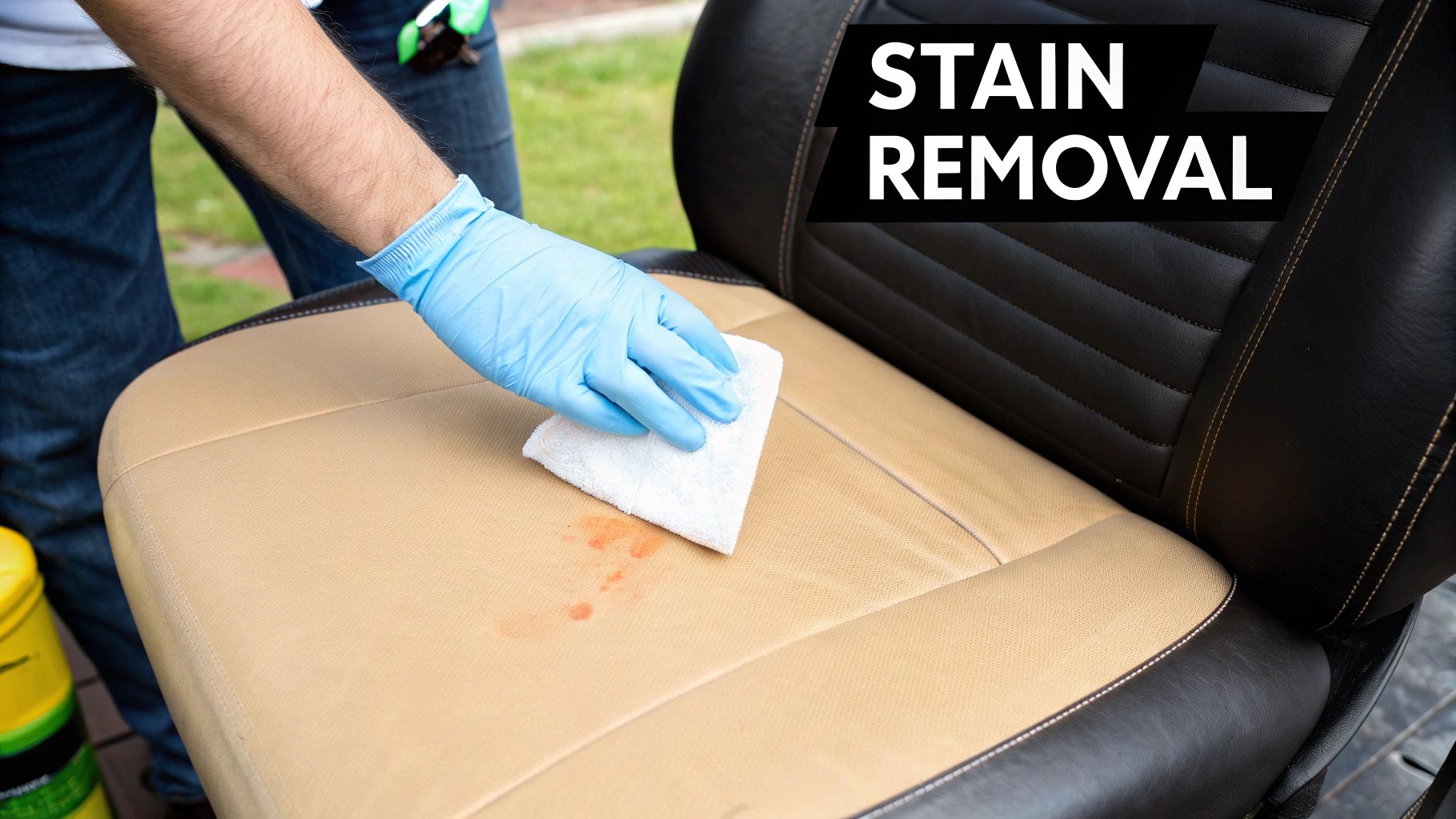
When you see those ugly black mildew spots crop up, your first instinct might be to grab straight bleach. Don't do it. Instead, reach for a dedicated mildew stain remover specifically formulated for marine vinyl. Apply it right on the spots, let it sit for a few minutes to really penetrate, and then gently agitate the area with a soft brush.
If mildew is a recurring nightmare for you, we’ve got a more detailed guide to help you out. Check out our article on winning the impossible battle against boat mildew.
Sunscreen stains are a whole other beast. The oils and chemicals can seep deep into the vinyl, leaving behind a stubborn yellow or orange haze that’s tough to get rid of. To break those down, you’ll need a cleaner with some real degreasing properties.
Targeted Solutions for Common Stains
Different stains need different tactics. A one-size-fits-all approach rarely works and, trust me, can sometimes make the problem even worse. Here’s a quick breakdown for the usual suspects:
- Ink Marks: If the ink is fresh, blot it immediately—whatever you do, don't rub. Use a cloth lightly dampened with isopropyl alcohol and dab gently until the stain lifts.
- Tree Sap: This sticky mess is best handled with a citrus-based cleaner. Apply it, let it sit for a bit to dissolve the sap, and then wipe it all away before doing a general clean.
- Food & Drink Spills: For spills like coffee or red wine, speed is your friend. A simple mixture of mild soap and water is often all you need if you catch it right away.
The growing popularity of boating has fueled a massive market for specialized cleaners. In fact, the global boat vinyl cleaner market was valued at an estimated $500 million in 2025. This growth is driven by boat owners becoming more aware of what it takes to do proper maintenance.
This huge demand for high-quality products just goes to show how crucial the right solution is for cleaning marine vinyl effectively. A word of advice from experience: always test any new product on a small, hidden area first. You want to make sure it doesn't cause any discoloration. By matching the right treatment to the specific stain, you can get your vinyl looking like new without causing any collateral damage.
Protecting Your Vinyl for the Long Haul
Getting your vinyl seats looking brand new is a great feeling, but the job's only half done. If you want them to stay that way, protection is everything. Once your vinyl is completely dry after a good cleaning, the next step is the most important one: applying a high-quality, marine-grade UV protectant.
Think of it as sunscreen for your upholstery. A good protectant creates an invisible shield that deflects the sun's harsh rays—the very thing that causes that faded, chalky look and leads to cracking over time.
But it’s not just about sun protection. A solid protectant also conditions the vinyl, keeping it soft and flexible. This is key to preventing splits and cracks, especially on high-traffic spots like the captain's chair or the corner of a bench seat where people are always sliding in and out.
Plus, you’ll find your future cleanups get a whole lot easier. When you use a quality boat interior vinyl protectant, it helps repel dirt, water spots, and even those pesky sunscreen stains before they get a chance to bake in.
A Simple Schedule for Year-Round Care
Consistency is your best friend when it comes to vinyl maintenance. Sticking to a simple routine will save you from marathon scrubbing sessions later and can genuinely add years to the life of your boat's interior.
Here’s a practical schedule that works for most boaters:
- During the Season: Plan on reapplying your UV protectant every 3-4 weeks. If you're out on the water every weekend under intense sun, you might even do it a little more often.
- End-of-Season: Before you put the boat away for the winter, do one last deep clean and then apply a really generous coat of protectant. This is your vinyl's defense for the long sleep.
- Off-Season Storage: Always use a breathable boat cover. You want air to circulate to stop moisture from getting trapped, which is a perfect recipe for mildew.
Making this a regular habit isn’t just another chore; it’s an investment. You’re actively preserving your boat's value and appearance, and it only takes a few minutes each month.
The growing demand for better marine care products is a good thing for all of us. Companies are developing more specialized and effective formulas, many with an eye toward being more eco-friendly. If you're interested, you can read more about the trends in the marine cleaning products market and see how it’s pushing innovation forward.
Got Questions About Cleaning Marine Vinyl?
Even when you have a good cleaning routine down pat, specific situations always come up. Getting the right answers can save you from making a costly mistake with your boat's upholstery. Let's dig into some of the questions we hear all the time.
Can I Use a Magic Eraser on My Boat Seats?
It's a common temptation, but reaching for a Magic Eraser is a huge mistake. Think of it as a super-fine sandpaper—it literally scrapes away the vinyl's protective top layer.
Doing this will immediately dull the finish, but the real damage comes later. That compromised surface is now wide open to staining and UV damage. Always, always stick with a soft-bristled brush to do your scrubbing. It's just as effective without causing harm.
A tool like a Magic Eraser might seem like a quick fix, but it causes irreversible damage. By stripping that essential protective layer, you're fast-tracking the vinyl's aging process, which can lead to expensive repairs or even full replacement down the line.
How Often Should I Deep Clean Marine Vinyl?
Getting into the habit of rinsing your vinyl with fresh water after every outing is fantastic for getting rid of salt and light grime.
When it comes to a deep clean with a proper marine vinyl cleaner, aim for every 2-4 weeks if you're out on the water a lot during the season. At the very least, you need to do a thorough cleaning and apply a UV protectant twice a year: once at the beginning of the season and again before you put the boat away.
What's the Best Way to Prevent Mildew?
Mildew is all about moisture, so controlling it is your number one defense. After a wash down or a rain shower, always wipe your seats dry with a clean towel. Don't just let them air dry.
Using a breathable boat cover is also a game-changer because it allows for air circulation. On nice, sunny days, open up all your compartments and let the boat air out completely. The final piece of the puzzle is a good marine vinyl protectant that contains a mildew inhibitor. This adds a crucial layer of defense that stops growth before it can even start.
For everything you need to keep your boat in prime condition—from heavy-duty cleaners to long-lasting protectants—you can count on the team at Better Boat. Check out our full lineup of boat care essentials at https://www.betterboat.com.




